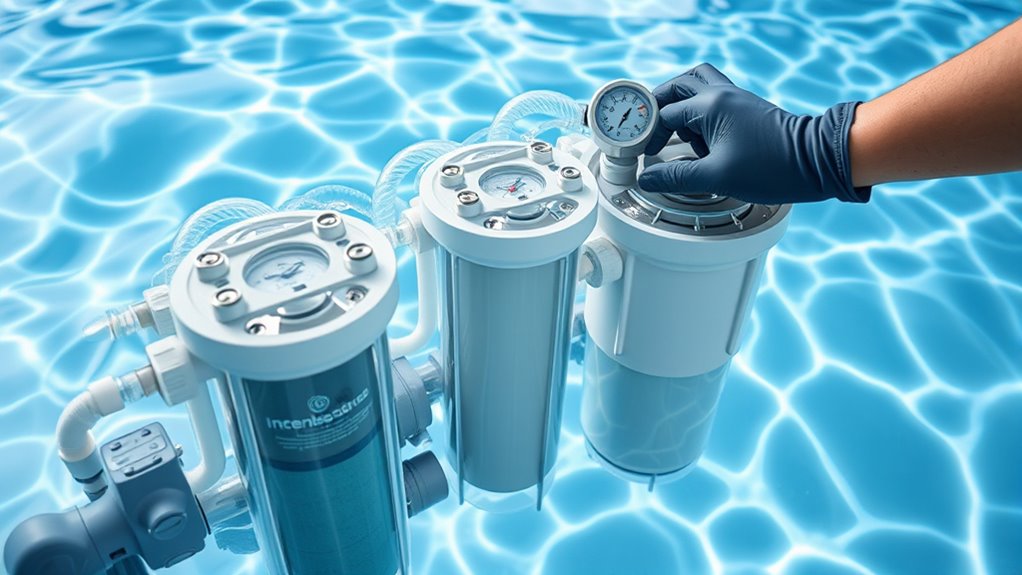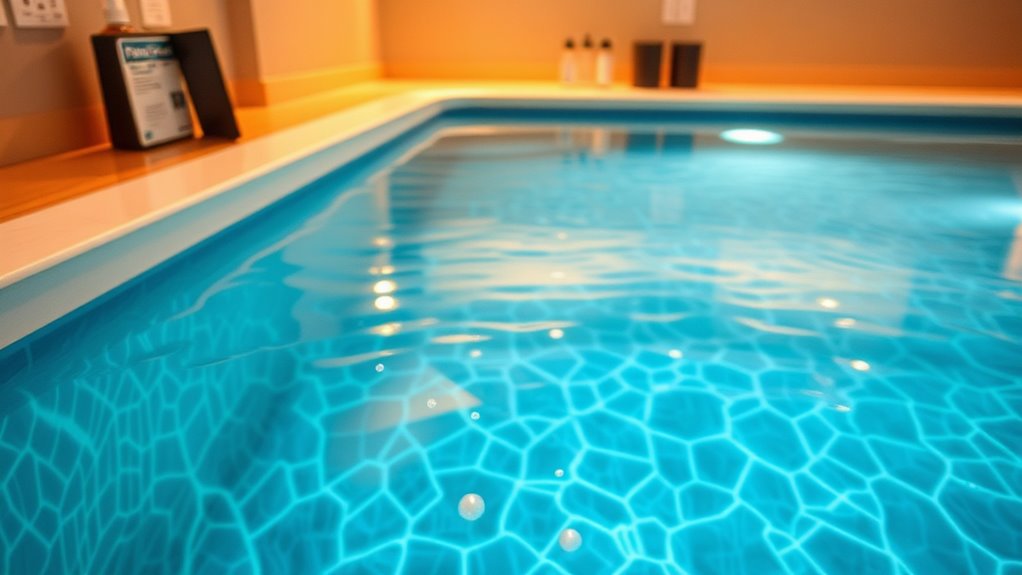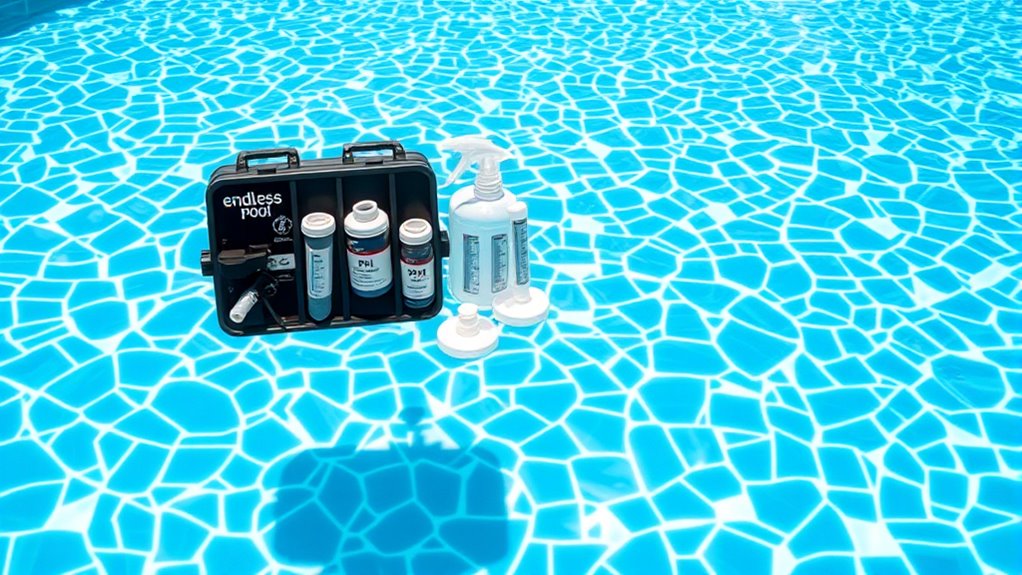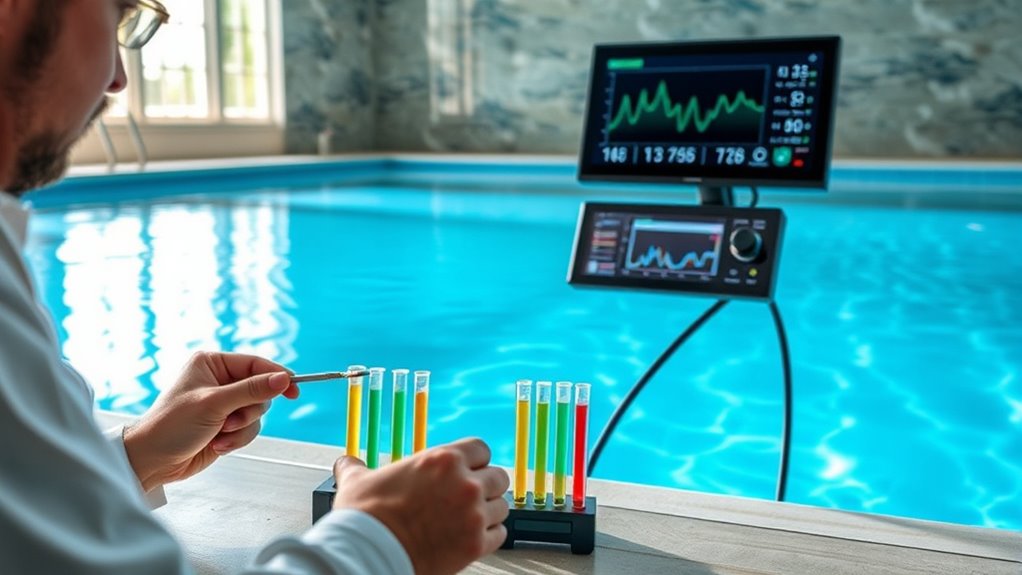If your endless pool water turns cloudy, start by checking your water chemistry—test pH, alkalinity, and sanitizer levels, and adjust as needed. Clean or replace filters and ensure your pump cycles properly to promote circulation. Remove organic debris and consider using clarifiers or shock treatments to clear up the water. Regular maintenance and monitoring can prevent future issues. Keep following these steps to discover more effective ways to restore crystal-clear water.
Key Takeaways
- Regularly test and balance water chemistry, including pH, alkalinity, and sanitizer levels, to prevent algae and mineral buildup.
- Clean and maintain the filtration system, including filters, hoses, and baskets, to ensure effective debris removal.
- Confirm proper pump operation and circulation to distribute chemicals evenly and prevent stagnation.
- Use clarifiers or enzyme treatments to bind particles and enhance filtration effectiveness.
- Perform shock treatments periodically to eliminate organic contaminants and algae growth.
Identifying Common Causes of Cloudy Water

Cloudy water in your pool or plumbing system often signals an underlying issue that needs attention. The most common causes include inadequate filtration, which allows dirt and algae to accumulate, making water appear murky. Poor water chemistry, such as imbalanced pH, alkalinity, or calcium hardness, can also contribute to cloudiness by encouraging algae growth or mineral deposits. Organic debris like leaves, dirt, and body oils can quickly cloud water if not regularly skimmed or cleaned. Additionally, insufficient sanitation, whether through chlorine or alternative sanitizers, allows bacteria and algae to thrive, turning water cloudy. The use of electric dirt bikes and related equipment demonstrates the importance of proper maintenance and performance, which is equally critical in pool care to prevent cloudiness. Understanding these causes helps you target the right solution, ensuring your water stays clear and inviting. Regular maintenance and monitoring are key to preventing these issues.
Checking and Balancing Water Chemistry

Properly checking and balancing your water chemistry is essential for maintaining clear, healthy water. Start by testing your water regularly with reliable test strips or a liquid test kit. Check key parameters like pH, alkalinity, and sanitizer levels to ensure they’re within ideal ranges. If your pH is too high or low, adjust it with pH increasers or decreasers. Maintain proper alkalinity to buffer pH fluctuations, and keep sanitizer levels (chlorine or bromine) balanced to prevent bacteria growth. Remember, imbalanced chemistry can lead to cloudy water, algae, or bacteria buildup. After adjustments, retest to confirm your water is balanced. Vetted – 1st Home Theatre Projector Regular testing and timely corrections will keep your Endless Pool crystal clear and safe for use.
Inspecting Filtration Systems and Maintenance

Regularly inspecting your filtration system is essential to keep your water clean and clear. Start by checking the filter for debris, dirt, or buildup, and clean or replace it as needed. Make sure the filter housing is secure and free of leaks. Inspect the hoses and connections for cracks or blockages, ensuring water flows smoothly through the system. Check the pump for unusual noises or vibrations, which could indicate a problem. Clean the skimmer and pump baskets regularly to prevent clogs. Review the system’s overall condition and look for signs of wear or corrosion. Proper maintenance extends the lifespan of your equipment and keeps the water crystal clear. Consistent inspections save you time and prevent costly repairs down the line. Recognizing soulmate angel numbers can also provide spiritual reassurance and guidance during your maintenance routine.
Managing Proper Circulation and Pump Functionality

Effective circulation is key to maintaining clean and healthy water. When your pump functions properly, it ensures even distribution of chemicals and prevents stagnation. Regularly check your pump for unusual noises or vibrations, which could signal issues. Confirm the pump operates at the correct flow rate for your pool size; too slow or too fast can cause problems. Use the table below to help identify circulation issues:
| Symptom | Possible Cause | Solution |
|---|---|---|
| Water is stagnant | Pump not running or low flow rate | Restart or upgrade your pump |
| Cloudy water | Poor circulation or filter issues | Increase pump runtime |
| Uneven chemical distribution | Inadequate flow | Adjust pump settings |
Maintaining proper pump operation prevents water quality issues and keeps your pool crystal clear. Additionally, understanding the contrast ratio of your pump and filter system can help optimize performance and water clarity.
Using Clarifiers and Additional Water Treatments

When water clarity declines despite your circulation efforts, using clarifiers and additional water treatments can help restore transparency. Clarifiers work by gathering tiny particles that cause cloudiness, making them heavy enough to be filtered out easily. Be sure to follow the manufacturer’s instructions for dosage, as overuse can cause other issues. Besides clarifiers, consider shock treatments to eliminate organic contaminants and algae inhibitors to prevent growth. If your water remains cloudy, enzyme-based treatments can break down organic buildup, improving clarity. Always test your water after applying treatments to ensure chemical balance. Remember, these solutions are meant to supplement proper filtration and sanitation, not replace them. Use clarifiers and treatments as part of a thorough approach to maintain clear, inviting water.
Preventative Measures to Maintain Water Clarity

Maintaining water clarity requires proactive measures to prevent issues before they arise. Regularly test your water’s pH and sanitizer levels, aiming for ideal ranges to inhibit algae growth and bacterial buildup. Keep your filtration system running daily, and clean or replace filters as recommended to guarantee it functions effectively. Shower before entering the pool to reduce oils, lotions, and dirt that can cloud the water. Maintain proper water circulation to distribute chemicals evenly and prevent stagnation. Additionally, monitor the water’s alkalinity and calcium hardness to avoid imbalance, which can cause cloudiness. Ensuring proper water flow helps keep the water clear and prevents debris buildup. Consistent maintenance, including routine shocking and cleaning, helps sustain clarity and reduces the need for extensive troubleshooting later. These preventative steps keep your pool pristine and inviting year-round.
Frequently Asked Questions
How Often Should I Test My Pool Water for Contaminants?
You should test your pool water at least once a week to keep it balanced and safe. If your pool gets heavy use or experiences weather changes, test more often—perhaps every 2-3 days. Regular testing helps you catch contaminants early, ensuring water stays clear and healthy. Don’t forget to check chlorine, pH, alkalinity, and other key levels to prevent cloudiness and maintain ideal water quality.
Can Algae Growth Cause Persistent Cloudiness in Pools?
Absolutely, algae love hanging out in cloudy pools just as much as you love a clear swim. When algae take hold, they create a persistent haze that just won’t quit. You’ll notice greenish hues, slimy surfaces, and water that refuses to sparkle. To clear it up, shock your pool, run the filter longer, and maintain proper chemical balance. Algae may be stubborn, but with some effort, clarity is always within reach.
What Are the Signs of a Failing Filtration System?
You’ll notice your filtration system is failing if your pool water remains cloudy despite regular cleaning, or if the flow rate slows noticeably. You might also hear strange noises from the filter or see debris bypassing it. If the pressure gauge shows high readings or if the pump struggles to start, these are signs it’s not functioning properly. Address these issues promptly to keep your pool water clear and safe.
How Do Temperature Changes Affect Water Clarity?
Temperature changes can dramatically impact your pool’s water clarity, sometimes making it look like a foggy mirror or a murky swamp overnight. When water gets warmer, algae and bacteria thrive, clouding the water and making filtration less effective. Conversely, cooler temperatures slow down biological growth, helping clarity. Sudden shifts can destabilize chemical balances, leading to cloudy water. Keep a close eye on temperature fluctuations to maintain crystal-clear, inviting water.
Are Natural Remedies Effective for Clearing Cloudy Water?
Natural remedies can help improve water clarity, but their effectiveness varies. You might try adding beneficial enzymes or algae-eaters like koi or certain aquatic plants to naturally balance your pool’s ecosystem. Regular maintenance, such as skimming debris and avoiding overuse of chemicals, also supports clear water. However, for persistent cloudiness, professional water testing and treatment are often more reliable than relying solely on natural solutions.
Conclusion
By following these simple steps, you’ll transform your cloudy endless pool into a crystal-clear oasis so stunning, it’ll make the Taj Mahal look dull! Say goodbye to murky waters and hello to sparkling, inviting clarity that’ll turn heads and wow your friends. With just a little vigilance and care, you’ll prevent foggy messes from taking over again—your pool will shine brighter than the sun itself! Plunge in confidently, knowing you’ve got the ultimate water quality secrets in your back pocket.










